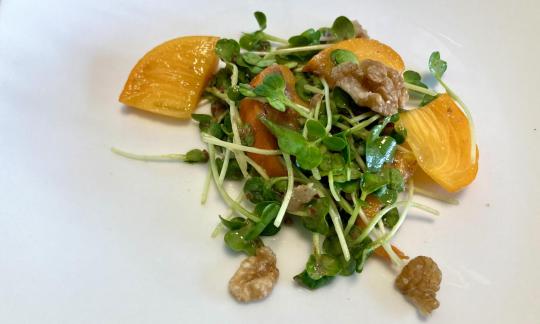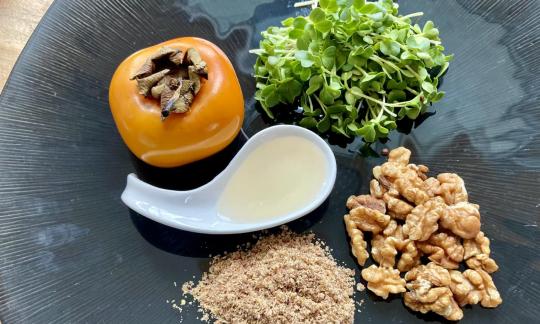Fruity, oil-free watercress salad with persimmon and walnut
raw-vegan
Ingredients (for servings, )
| For the basis | |
|---|---|
| 2 ¾ oz | Watercress (watercress), raw (organic?) |
| 1 | Persimmon (5.3 oz) |
| For the dressing | |
| 3 tbsp | Balsamic vinegar, white (Condimento bianco, organic?, raw?) (1.7 oz) |
| 2 tbsp, ground | Linseed, raw, organic? (golden linseed, flax) (0.49 oz) |
| Optional | |
| 1 dash | Table salt (table salt, raw?, organic?) (0.01 oz) |
| topping | |
| 1 oz | Walnuts (tree nuts), raw (organic?) |
Equipment
- coffee grinder, electric
- sieve
Type of preparation
- chop or grind
- food preparation without heating
- season to taste
- drain
Preparation
For the salad
Cut the watercress, put it in a sieve, wash it and let it drain. Wash the persimmon and cut it into thin slices. Halve these again.80 g of watercress (for 2 portions) corresponds to about 2 bowls.
Alternatives: Instead of watercress, you can also use the more readily available radish sprouts or the slightly milder broccoli sprouts.
For the dressing
Grind the flaxseed in a coffee grinder. Mix with balsamic vinegar and optionally season with a little salt.Finishing the salad
Pour the salad into salad bowls and pour the dressing over it. Sprinkle with chopped walnuts.
|
Nutritional Information per person
Convert per 100g
|
2000 kcal | |
|---|---|---|
| Energy | 223 kcal | 11.2% |
| Fat/Lipids | 13 g | 18.7% |
| Saturated Fats | 1.3 g | 6.3% |
| Carbohydrates (inc.dietary fiber) | 24 g | 8.9% |
| Sugars | 18 g | 19.8% |
| Fiber | 5.1 g | 20.5% |
| Protein/Albumin | 5.0 g | 10.0% |
| Cooking Salt (Na:100.3 mg) | 255 mg | 10.6% |
| Essential micronutrients with the highest proportions | per person | 2000 kcal | |
|---|---|---|---|
| Fat | Alpha-Linolenic acid; ALA; 18:3 omega-3 | 3.0 g | 149.0% |
| Vit | Vitamin K | 101 µg | 134.0% |
| Fat | Linoleic acid; LA; 18:2 omega-6 | 6.2 g | 62.0% |
| Min | Manganese, Mn | 0.82 mg | 41.0% |
| Min | Copper, Cu | 0.37 mg | 37.0% |
| Vit | Vitamin C (ascorbic acid) | 29 mg | 37.0% |
| Vit | Vitamin A, as RAE | 264 µg | 33.0% |
| Prot | Tryptophan (Trp, W) | 0.07 g | 27.0% |
| Prot | Threonine (Thr, T, irreversibly transaminated) | 0.22 g | 24.0% |
| Elem | Phosphorus, P | 140 mg | 20.0% |
Detailed Nutritional Information per Person for this Recipe
The majority of the nutritional information comes from the USDA (US Department of Agriculture). This means that the information for natural products is often incomplete or only given within broader categories, whereas in most cases products made from these have more complete information displayed.
If we take flaxseed, for example, the important essential amino acid ALA (omega-3) is only included in an overarching category whereas for flaxseed oil ALA is listed specifically. In time, we will be able to change this, but it will require a lot of work. An “i” appears behind ingredients that have been adjusted and an explanation appears when you hover over this symbol.
For Erb Muesli, the original calculations resulted in 48 % of the daily requirement of ALA — but with the correction, we see that the muesli actually covers >100 % of the necessary recommendation for the omega-3 fatty acid ALA. Our goal is to eventually be able to compare the nutritional value of our recipes with those that are used in conventional western lifestyles.
| Essential fatty acids | per person | 2000 kcal |
|---|---|---|
| Alpha-Linolenic acid; ALA; 18:3 omega-3 | 3.0 g | 149.0% |
| Linoleic acid; LA; 18:2 omega-6 | 6.2 g | 62.0% |
| Essential amino acids | per person | 2000 kcal |
|---|---|---|
| Tryptophan (Trp, W) | 0.07 g | 27.0% |
| Threonine (Thr, T, irreversibly transaminated) | 0.22 g | 24.0% |
| Isoleucine (Ile, I) | 0.22 g | 18.0% |
| Valin (Val, V) | 0.27 g | 17.0% |
| Phenylalanine (Phe, F) | 0.24 g | 16.0% |
| Leucine (Leu, L) | 0.37 g | 15.0% |
| Lysine (Lys, K, irreversibly transaminated) | 0.21 g | 11.0% |
| Methionine (Met, M) | 0.08 g | 8.0% |
| Vitamins | per person | 2000 kcal |
|---|---|---|
| Vitamin K | 101 µg | 134.0% |
| Vitamin C (ascorbic acid) | 29 mg | 37.0% |
| Vitamin A, as RAE | 264 µg | 33.0% |
| Vitamin B1 (Thiamine) | 0.22 mg | 20.0% |
| Vitamin B6 (pyridoxine) | 0.20 mg | 15.0% |
| Vitamin B9, B11 (Folate, as the active form of folic acid) | 30 µg | 15.0% |
| Vitamin B7 (Biotin, ex vitamin H) | 6.7 µg | 13.0% |
| Vitamin E, as a-TEs | 1.1 mg | 9.0% |
| Vitamin B2 (Riboflavin) | 0.10 mg | 7.0% |
| Vitamin B5 (Pantothenic acid) | 0.43 mg | 7.0% |
| Vitamin B3 (Niacin) | 0.80 mg | 5.0% |
| Essential macroelements (macronutrients) | per person | 2000 kcal |
|---|---|---|
| Phosphorus, P | 140 mg | 20.0% |
| Potassium, K | 390 mg | 20.0% |
| Magnesium, Mg | 66 mg | 17.0% |
| Sodium, Na | 100 mg | 13.0% |
| Calcium, Ca | 87 mg | 11.0% |
| Essential trace elements (micronutrients) | per person | 2000 kcal |
|---|---|---|
| Manganese, Mn | 0.82 mg | 41.0% |
| Copper, Cu | 0.37 mg | 37.0% |
| Iron, Fe | 1.2 mg | 9.0% |
| Zinc, Zn | 0.84 mg | 8.0% |
| Selenium, Se | 2.9 µg | 5.0% |
| Iod, I (Jod, J) | 1.9 µg | 1.0% |
| Fluorine, F | 11 µg | < 0.1% |
The fruity, oil-free watercress salad with persimmon and walnut is quick and easy to make and healthy.
Nutrient profile: According to GDA guidelines, one portion of this salad covers over 1.5 times the average daily requirement of omega-3 fatty acids and over 100% of that of vitamin K. The ratio of omega-6 to omega-3 fatty acids is 2:1, which is significantly below the recommended ratio of 5:1.
You can find further information on this topic at the following link: Vegans often eat unhealthily. Avoidable nutritional errors.
Portion information: The specified amount of 2 portions is sufficient as a side dish or starter for 2 people.
Watercress: True watercress prefers to grow in water, which is why it is also called watercress. It is best to grow raw organic watercress yourself (see tips), as it is only sporadically available in stores (in supermarkets, organic shops or weekly markets). You can also buy it as sprouted seeds or in pots. Watercress has a characteristically sharp taste, which it owes to the mustard oil glycosides it contains.
Persimmon: Persimmons are round, orange to reddish fruits that have a sweet, apricot-like aroma. When firm and not fully ripe, some varieties contain a lot of tannins, which cause a bitter taste and a furry, rough and astringent sensation. During the ripening process, however, the concentration of tannins decreases, which is why the fruits of the corresponding varieties are generally eaten when ripe or overripe. Persimmon and Sharon are cultivated forms of persimmon that have fewer tannins due to breeding and are therefore edible when firm. These varieties are preferable for the salad presented here.
Walnuts: In Central Europe, the common walnut ( Juglans regia) is particularly important. In addition to preparing and refining various dishes and desserts, walnuts are also used to make walnut oil. Of all known nuts, walnuts have the highest proportion of alpha-linolenic acid (ALA). They also have health benefits thanks to their high levels of tocopherols (forms of vitamin E) and many trace elements.
Growing watercress: As a potted plant, this actual marsh and aquatic plant needs a nutrient-rich mix of sand, garden soil and compost. The container is placed in a bowl of fresh water, which is changed daily. For a 15-20 cm pot, use three to four cuttings. Shoots can be pinched off to encourage bushy growth. Root cuttings can be propagated directly in water.
You can also grow watercress yourself without soil in a germination device on the windowsill.
Instead of watercress, which is not easy to get, you can also use the more readily available radish sprouts or the slightly milder broccoli sprouts.






